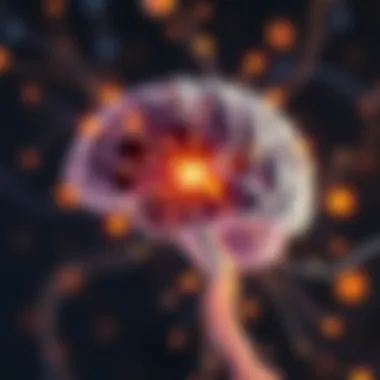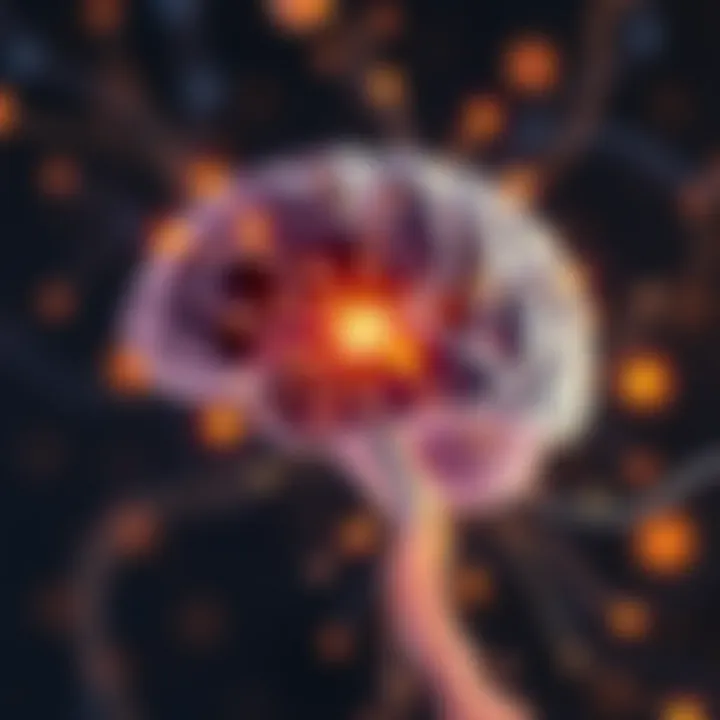Navigating the Path to Sobriety from Pain Pills


Intro
The road to recovery from pain pill dependence is anything but straightforward. It often winds through valleys of despair and peaks of hope. For many, this journey becomes an essential chapter in the story of their lives, where they learn not only how to reclaim their physical health but also their mental and emotional well-being. Understanding the intricate dance between pain relief and dependence is critical. It illuminates the path toward true recovery.
As we explore this guide, we will navigate through the physiological and psychological contours of addiction. From identifying signs of dependence to adopting effective coping strategies, each section serves to equip readers with practical tools. The aim is clear: to provide a comprehensive roadmap that fosters sustainable recovery from the clutches of pain pill addiction.
Understanding Mental Health and Well-being
Navigating the turbulent waters of substance dependence cannot be done without first examining the undercurrents of mental health. Just as a sturdy vessel needs a solid foundation, so too does an individual need to prioritize their mental health to steer clear of the stormy seas of addiction.
What is Mental Health?
Mental health encompasses our emotional, psychological, and social well-being. It is the framework through which we manage stress, make choices, and relate to others. More than just the absence of a mental disorder, it reflects a state of overall well-being that can be nourished or neglected depending on life's circumstances.
The Importance of Prioritizing Mental Well-being
Prioritizing mental well-being is akin to tending a garden. Without regular care, weeds of stress and anxiety can take root, choking out positive thoughts and healthy emotions. In the context of recovery, embracing mental well-being can enhance resilience and improve the ability to handle setbacks. It is vital not only for recovery but also for maintaining a balanced life free from the shadow of addiction.
Common Mental Health Challenges and Disorders
Individuals battling pain pill dependence often encounter various mental health challenges. Common issues may include anxiety disorders, depression, and even elements of post-traumatic stress. Each of these can manifest differently, making early recognition and intervention critical. For example, feelings of worthlessness can emerge as a response to dependency, perpetuating the cycle of addiction.
Strategies for Improving Mental Health
Strengthening mental health requires a deliberate and multifaceted approach. Self-care techniques can serve as the stepping stones toward emotional stability; implementing certain practices can aid in recovery's ebb and flow.
Self-care Techniques and Practices
Integrating simple acts of self-care can make a significant difference. This includes activities like journaling, which allows for reflection, or engaging in hobbies that bring joy. Also, reaching out to friends or family can create supportive networks, nurturing the emotional side of recovery.
Building Resilience and Stress Management
Life will bring challenges, and building resilience helps equip individuals to face those hurdles with strength. Developing effective stress management techniques—be it through mindfulness, breathing exercises, or physical activities—can be transformative. When faced with cravings or emotional turmoil, these skills become essential allies in the battle against relapse.
Seeking Professional Help: Therapy and Counseling
For some, the support of professionals can provide the guidance needed to navigate the turbulent waters of withdrawal and recovery. Therapy options vary, from cognitive behavioral therapy to group therapy, offering invaluable perspectives that foster hope and healing.
"Seeking help is a sign of strength, not weakness. It takes courage to face the shadows and step into the light of recovery."
Finding Balance in Life
Achieving a sustainable lifestyle during recovery requires a focus on balance. This includes evaluating health habits, practicing mindfulness, and managing time more effectively.
Healthy Lifestyle Choices: Diet, Exercise, and Sleep
Maintaining a nutritious diet, regular physical activity, and good sleep is crucial to overall well-being and recovery. Nutrition fuels the body, while exercise releases endorphins that uplift mood. Adequate sleep, often overlooked, plays an essential role in mental clarity and emotional stability.
Mindfulness and Meditation Practices
Mindfulness practices encourage individuals to live in the moment, significantly reducing anxiety and enhancing focus. Techniques such as guided meditation can empower individuals recovering from pain pill dependency to foster a more profound connection with themselves.
Setting Boundaries and Managing Time Effectively
One often overlooked aspect of recovery is the importance of setting boundaries. Learning to say no to situations that may compromise recovery is essential. Additionally, managing time effectively helps create a structured routine that can reduce the overwhelming feelings that may accompany withdrawal.
Enhancing Personal Development
Personal growth does not end with recovery, it often begins anew. Setting concrete goals and developing resilience can pave the way for a flourishing life beyond addiction.
Goal Setting and Productivity Tips
Establishing achievable goals can serve as a roadmap for personal development. Whether it's working towards a healthier lifestyle or pursuing a new career, creating a clear set of objectives provides direction and motivation.
Building Healthy Relationships and Social Connections
Recovering individuals should actively foster relationships that support their new lifestyle. Surrounding oneself with positive influences can greatly enhance the recovery experience, forming a network of encouragement and accountability.
Practicing Gratitude and Positivity
Fostering gratitude helps shift focus from challenges to blessings. Regularly reflecting on what one is thankful for creates a positive mindset that is integral to the recovery journey.
Tips for Maintaining Mental Well-being
Recovery involves ongoing effort. Recognizing and addressing potential pitfalls can be the difference between relapsing and sustaining progress.
Strategies for Preventing Burnout
Engaging in too many activities or neglecting self-care can lead to burnout, which often precedes relapses. Finding balance, along with monitoring emotional states, can prevent spirals of overwhelming stress.
Coping with Challenges and Setbacks
Setbacks are part of the recovery process. Developing effective coping mechanisms, such as open communication with support networks, is critical in navigating these turbulent times.
Creating a Supportive Environment


Finally, an environment that nurtures recovery is paramount. This could mean removing temptations or fostering an atmosphere of positivity at home. Emotional support can come from many sources, including communities online, such as forums on reddit.com or social groups on facebook.com.
The path to sobriety is undoubtedly a complex journey, but it is also one filled with potential for growth and renewal. By prioritizing mental health, adopting effective strategies, and seeking out supportive environments, individuals can reclaim autonomy over their lives and embrace the possibility of a future free from the burdens of addiction.
Understanding Pain Pill Dependence
Understanding pain pill dependence is pivotal for anyone considering the journey to sobriety. Grasping this concept sheds light on why recovery can feel overwhelming yet entirely attainable. Pain pills, often prescribed to alleviate discomfort, can lead to unintended pathways of dependence, impacting one’s physical and psychological well-being. Recognizing this dependence is the first step not just to recovering from substances, but to reclaiming control over one's life.
Defining Pain Pill Dependence
Pain pill dependence refers to a state where an individual feels a compulsive need to consume analgesics—not because they are managing pain, but because their body has become accustomed to these substances. The line blurs between prescribed usage and reliance, creating a slippery slope that many unaware of the implications might slide down.
A critical factor in defining pain pill dependence lies in understanding tolerance, which occurs when increasing amounts of medication are needed to achieve the same effect. Over time, individuals may find themselves unable to function normally without the drug, leading to a troubling cycle of dependency.
The Mechanisms of Pain Relief Medications
Pain relief medications, particularly opioids like oxycodone and hydrocodone, offer quick relief for those suffering from acute or chronic pain. These medications interact with specific receptors in the brain, providing the desired alleviation. However, the very efficacy that helps to relieve pain also leads to dependence, as the brain begins to adjust to the altered chemistry caused by these drugs.
When opioids bind to their receptors, they release large amounts of dopamine, a neurotransmitter tied to feelings of pleasure and satisfaction. This rush can create a feedback loop, encouraging individuals to seek the drug for more than just pain relief. Understanding these mechanisms can empower those struggling with addiction to seek help and recognize the biological hurdles in their path.
Signs and Symptoms of Dependence
Recognizing the signs and symptoms of pain pill dependence can be pivotal for both oneself and loved ones. Some key indicators include:
- Increased Tolerance: Needing more of the medication to feel its effects.
- Withdrawal Symptoms: Experiencing physical or mental issues when the medication is not available.
- Neglecting Responsibilities: Skipping work, missing social events, or losing interest in hobbies can signal a shift in priority.
- Continued Use Despite Harm: Persisting in taking pain pills even when faced with negative consequences, such as health issues or relationship struggles.
Identifying these symptoms early can initiate a much-needed conversation about recovery. Being proactive can transform not only personal experiences but also influence family and friends, who might be oblivious to the extent of the situation.
Understanding the signs is crucial. Many individuals might not even realize they are dependent until it's painfully obvious. The sooner this is recognized, the better the chance for a successful recovery.
Initial Steps to Sobering Up
Taking the initial steps towards sobriety is a pivotal part of recovery. It sets the stage for everything that follows in the journey of overcoming pain pill dependence. These early actions are vital as they allow individuals to realize the depths of their situation and recognize that change is not just necessary but possible. Often, the road to recovery feels daunting, yet it becomes a path of empowerment when approached methodically.
What may seem like a simple first step can lead to profound changes in one’s life. Often, it’s about peeling back the layers of confusion and denial that may have built up over time. A key element in this phase involves understanding that seeking help is not a sign of weakness but rather an important leap toward healing. It’s essential to grasp that many have been in the same boat and that support is available.
Recognizing the Need for Change
Admitting that there is a problem can be one of the toughest hurdles to cross. Many people stay in a cycle of use, thinking they can control it or that they are merely going through a rough patch. However, the need for change often becomes evident when individuals start experiencing negative effects on their relationships, work, and overall health.
An important realization occurs when one starts assessing their behaviors and thoughts surrounding pain medication. Reflecting on questions like "How has this affected my life?" or "Am I relying on these pills more than I thought?" can catalyze this acknowledgment. It’s a personal awakening, which usually leads to a deeper comprehension that continuing on this path is untenable.
Seeking Professional Help
Once the realization sinks in, the next logical step is reaching out for professional support. This doesn’t just mean finding any doctor; it involves seeking those who specialize in addiction medicine or have experience with recovery programs. Professionals can aid in easing the transition away from pain pills through tailored plans that fit individual needs.
Support can come in many forms:
- Medical professionals – They can assess the dependency level and help with potential detoxification.
- Therapists and counselors – Working through behavioral patterns that lead to substance use is crucial.
- Support groups – Joining groups like Narcotics Anonymous can foster a sense of community and accountability.
Professional guidance and support can provide the roadmap necessary for a successful recovery journey.
Finding the right professional help can be like finding a lighthouse guiding you through a stormy sea. It’s about establishing trust and knowing that there are strategies designed to assist every unique situation. Remember, you’re not alone and there are dedicated people and resources eager to help you find your way back.
Understanding Withdrawal Symptoms
Understanding withdrawal symptoms is a crucial step for anyone on the journey to sobriety from pain pills. Recognizing and comprehending these symptoms can make a world of difference when it comes to managing the recovery process. Each person's experience with withdrawal is unique. For many, the physical and psychological responses can be intense; knowing what to expect can often mitigate anxiety. Knowledge serves as a beacon for those in distress, guiding them through the darkness of withdrawal.
Common Physical Withdrawal Symptoms
Physical withdrawal symptoms can vary widely but are often the most immediate and noticeable aspect of reducing dosage or stopping pain pill use altogether. Some of the most common issues individuals might face include:
- Nausea and vomiting: A sensitivity in the digestive system can lead to these distressing feelings.
- Muscle aches and pains: Many report a feeling akin to the flu, with their muscles feeling sore and achy.
- Sweating and chills: The body's regulatory systems are thrown out of whack, resulting in hot flashes followed by chills.
- Fatigue: An overwhelming sense of tiredness can accompany the body as it adjusts.
- Insomnia: Sleep disturbances might occur, leaving individuals fighting a restless night’s sleep.
It’s important to understand that these symptoms are not just discomfort; they are the body’s way of reacting to the absence of substances it has grown accustomed to. For instance, if someone has been using hydrocodone for chronic pain, their body has been adapting to that substance. When it abruptly leaves, a reaction is expected.
Psychological Withdrawal Symptoms
Beyond the physical symptoms lies an intricate web of psychological challenges that may emerge during withdrawal. These can include:
- Anxiety and irritability: Many experience heightened levels of nervousness or become easily agitated.
- Depression: Mood swings or episodes of deep sadness can dominate one’s emotional state post-withdrawal.
- Cravings: This is one of the more challenging aspects, often becoming overpowering urges to return to pain pills for relief.
- Cognitive impairments: Some people may struggle with focus or memory, finding daily tasks mentally exhausting.
The interplay between physical discomfort and mental distress creates a feedback loop that can complicate recovery. Without proper guidance, individuals might find themselves caught in this cycle, unable to break free from the grips of dependence.
Duration of Withdrawal Symptoms
How long withdrawal symptoms last is a question that many ask as they prepare for what lies ahead. While it varies by individual, several factors come into play:
- Duration of use: Those who have been on pain medications for a longer period might experience more prolonged withdrawal.
- Type of medication: Certain opioids have longer half-lives, affecting how the body adapts when they are taken away.
- Overall health: An individual's physical health and mental fortitude can significantly impact the duration and intensity of withdrawal symptoms.
Generally, physical symptoms may peak within the first few days and begin to taper off within one to two weeks. Psychological symptoms, however, could linger longer, often requiring additional support and intervention. It’s crucial to approach this time with care, using coping strategies and support networks to navigate these challenges effectively.
"Knowledge is power. The more you understand your body and its responses, the better equipped you are to handle the road ahead."
Navigating the withdrawal process can feel like traversing a difficult landscape. However, educating oneself about what lies ahead can instill a sense of control and empowerment. With steadfast resolve and the right strategies, overcoming withdrawal and attaining a sober life becomes a more attainable goal.
Coping Strategies During Withdrawal


Coping strategies during withdrawal from pain pills play a crucial role in not just easing the discomfort of the process but also laying the groundwork for long-term recovery and stability. As one undergoes the ordeal of withdrawal, it is vital to have a grasp of effective methods to manage both physical and psychological challenges that arise. Investing time and effort into coping strategies can significantly alleviate the effects of withdrawal, boost resilience, and equip one with tools necessary for navigating the bumps on the road to sobriety.
Physical Exercise and Its Benefits
In the midst of pain pill withdrawal, physical exercise can be a game changer. Engaging in regular activity helps to counteract the symptoms of withdrawal, both physically and mentally. Exercise acts as a natural mood lifter, thanks to the endorphins it releases, which are often dubbed the body's "feel-good" hormones. Even a simple daily routine of walking can increase energy levels and enhance sleep quality, which may suffer significantly during the early stages of recovery.
Furthermore, incorporating physical activity into one’s regimen aids in rebuilding a sense of control over the body. This newfound agency can be particularly liberating for individuals who have felt dominated by the grips of addiction.
Benefits of Physical Exercise:
- Enhanced Mood: Exercise releases endorphins that can help improve mood and reduce feelings of anxiety or depression.
- Improved Sleep: Regular activity can help regulate sleep patterns, leading to more restorative sleep cycles.
- Increased Energy: Consistent movement combats lethargy, often experienced during withdrawal.
- Sense of Accomplishment: Completing a workout can bolster self-esteem, making you feel capable and strong.
Mindfulness and Relaxation Techniques
Mindfulness and relaxation strategies can be pivotal during withdrawal as they help to ground individuals in moments of crisis. Practices such as deep breathing, meditation, and yoga foster a sense of calm and can help quell the storms of emotional upheaval that often accompany withdrawal. When one learns to be present in the moment without judgment, it reduces anxiety about the future and resentment about the past.
Developing a formal mindfulness practice could involve setting aside time each day to focus on nothing but the breath or engaging in guided meditation. This does not require extensive training; what matters is consistency. The brain can benefit from even short bursts of mindfulness, resulting in improved focus and lowered levels of stress.
Relaxation Techniques:
- Deep Breathing: Inhale deeply through your nose, hold for four seconds, then exhale through your mouth. Repeat this for a few minutes to help calm the nervous system.
- Guided Imagery: Utilize audio recordings to visualize peaceful settings, or mentally transport yourself to a place you find calming.
- Progressive Muscle Relaxation: Slowly tense and then relax each muscle group in your body, which can help release built-up tension.
"Mindfulness cultivates a refuge within, providing strength when facing the storms of withdrawal."
Nutrition and Hydration Considerations
When someone embarks on the journey of withdrawal, nutrition and hydration should never be sidelined. The body is under tremendous stress, and having adequate nutritional support can ease many of the uncomfortable symptoms associated with withdrawal.
A balanced diet rich in whole foods can furnish the body with vital nutrients that it craves. Focus on whole grains, lean proteins, fruits, and vegetables to not only promote healing but also to stabilize blood sugar levels. Heavy processed foods can lead to fluctuations in energy and mood, which is counterproductive during this delicate time.
Hydration, too, plays a significant role. The discomfort of withdrawal can often lead to sweating or dehydration. Drinking plenty of water throughout the day can assist in flushing out toxins and improving overall well-being.
Nutrition Tips:
- Focus on Whole Foods: Fresh fruits, vegetables, and whole grains provide essential vitamins and minerals.
- Limit Sugar and Processed Foods: These can exacerbate feelings of anxiety and disrupt mood stability.
- Stay Hydrated: Aim for at least eight glasses of water daily or more, especially if sweating occurs.
In summary, coping strategies during withdrawal encompass a multifaceted approach. Integrating physical exercise, mindfulness practices, and sound nutrition can greatly assist individuals on their recovery journey, making the daunting path of sobering up feel much more manageable.
The Role of Support Systems
In the challenging landscape of recovery from pain pill dependence, the role of support systems cannot be understated. The journey to sobriety is often steep and riddled with obstacles, and having a solid network can make a tangible difference. A robust support system provides emotional backing, practical assistance, and accountability. This is key in a journey where loneliness can easily cast a long shadow over one’s resolve.
Family and Friends as Support
Family and friends can be a pillar of strength during recovery. They often know an individual best, being the ones who have seen the highs and lows. This intimacy can foster an environment of understanding and empathy. When loved ones actively engage in the recovery process—whether it’s by attending therapy sessions, helping find coping mechanisms, or simply being present for conversations—it can make the road feel less daunting.
However, it’s important to have honest discussions about boundaries and expectations. Not every relationship is beneficial; some might unintentionally trigger old habits. Therefore, choosing whom to lean on is vital. Establishing clear communication about the recovery process helps in aligning expectations and minimizes misunderstandings. Whether it’s a parent reminding you of your strength or a close friend lifting your spirits, these connections can cultivate resilience.
Support Groups and Community Resources
Support groups can be a lifeline for those recovering from pain pill dependence. In a group setting, individuals share personal stories, strategies, and feelings with others on similar journeys. There’s a unique power in shared experiences—being able to voice struggles and triumphs among peers cultivates a sense of belonging. Organizations such as Narcotics Anonymous or local community programs can provide crucial networking opportunities. These environments foster encouragement and accountability, allowing individuals to witness that they’re not alone in their challenges.
Community resources extend beyond support groups. Various organizations often offer tools like education on addiction, strategies for managing stress, and even workshops on developing new skills. Engaging with these resources can brighten the path to recovery. You can find such resources on government sites or nonprofit health organizations. Remember, it’s okay to seek help and know that numerous hands are stretched out to guide you.
Professional Therapy Options
Professional therapy represents another significant aspect of a supportive recovery framework. Trained therapists can provide tailored guidance addressing individual issues specific to pain pill dependence. Therapy options vary widely, including cognitive behavioral therapy, which offers practical tools to help reshape thought patterns, and more holistic approaches focusing on mindfulness and emotional health.
Moreover, working with a professional can help dissect deeper issues that might have contributed to substance use—potential past traumas or underlying mental health disorders. Establishing a relationship with a therapist can pave the way for discovering root causes, which ultimately aids in building lasting recovery skills. In many cases, having a licensed therapist on your side can be the difference between temporary relief and genuine recovery.
"Support is not just about being there; it’s actively participating and understanding the journey together."
Developing a Sustainable Recovery Plan
Creating a sustainable recovery plan is crucial for anyone on the road to sobering up from pain pill dependence. Without a structured approach, the journey can resemble steering a ship without a compass—tricky and uncertain. A well-planned roadmap helps individuals navigate the ups and downs of recovery with clarity, focusing on long-term success rather than short-term fixes.
A sustainable recovery plan lays the foundation for healthy habits and behaviors. It emphasizes self-accountability while still allowing space for adjustments as life inevitably throws curveballs. It's like building a life raft when you're out at sea—you need it to hold you steady amid turbulent waters.
Setting Realistic Goals
When developing a recovery plan, the first order of business is setting realistic goals. It's tempting to aim for the stars, but aiming too high can lead to unnecessary frustration and disappointment. To keep your journey grounded, goals should be specific, measurable, achievable, relevant, and time-bound (SMART). This approach fosters a sense of accomplishment and keeps you motivated.
- Specific: Instead of saying, "I want to feel better," specify what better looks like. You might say, "I want to attend three support group meetings a week."
- Measurable: Ensure you can track your progress. This could mean monitoring the number of days sober or the consistency of your counseling sessions.
- Achievable: Make sure your goals are within reach. If three meetings a week feels overwhelming, start with one weekly meeting and gradually increase.
- Relevant: Goals should reflect your personal desires for recovery. Each goal should resonate with your journey and speak to your individual circumstances.
- Time-bound: Setting deadlines creates urgency. Perhaps aim for completing a certain number of therapy sessions within the next month, which gives you a timely motivator.
Setting realistic goals provides stability and focus, and these little victories build up and can encourage a positive mindset.
Monitoring Progress and Adjusting Plans
As the saying goes, "what gets measured gets managed." Monitoring your progress is a cornerstone of a successful recovery plan. Regular check-ins allow you to see what’s working and what might need a second look. Noticing patterns, both in positive and negative moments, can reveal insights into your recovery journey.
- Journaling: Write down your thoughts and feelings regularly. This practice can highlight progress and areas needing adjustment. Just like a ship captain takes notes on the weather, you do the same in tracking your emotional climate.
- Feedback loops: Encourage open conversations with trusted individuals—this might include friends or therapists. They can offer perspectives or observations you might overlook. It’s like having a co-pilot in the cockpit, providing guidance when needed.
- Reassessing goals: Life can be unpredictable, and sometimes your goals may need to shift. If ongoing challenges arise, don’t hesitate to modify your plans. Flexibility is key; rather than seeing it as failure, view it as an adjustment to steer your path more effectively.
- Celebrate successes: Acknowledge your achievements, no matter how small they may seem. Each step forward is significant in this journey; even days of gaining insights should be celebrated as steps on the path to recovery.
In essence, developing a sustainable recovery plan is about creating a framework that supports your journey towards sobriety. Setting realistic goals anchors your aspirations, while regular monitoring ensures you're moving in the right direction. Taking time to reflect and adapt your plan not only optimizes your progress but also empowers you, making the recovery process a collaborative effort between you and your evolving needs.
Preventing Relapse
Preventing relapse is a crucial aspect of the journey towards sobriety. It’s not just about quitting pain pills; it’s about steering clear of that slippery slope for good. The fight against substance dependence doesn’t end when you stop using. Instead, it requires ongoing awareness, vigilance, and a proactive approach. This section delves into some key elements of preventing relapse, highlighting its significance and practical considerations that should be integrated into a recovery plan.


Relapse can occur even after an individual has achieved a period of sobriety. Understanding the ins and outs of this potential pitfall is essential in establishing a solid foundation for long-term recovery. When individuals are aware of their vulnerabilities and the possible triggers that could lead them back to using pain medication, they can take proactive steps to stay on the straight and narrow.
Understanding potential relapse triggers and how to manage cravings is fundamental for maintaining sobriety, creating a resilient mindset and ensuring long-term success in recovery.
Recognizing Triggers and Cravings
The first line of defense in relapse prevention is recognizing triggers and cravings. Triggers can be emotional, situational, or even environmental. For instance, a stressful job, certain social settings, or even seeing someone who uses pain pills can provoke strong urges to use again. It’s imperative to become attuned to these triggers as they can sneak up when least expected.
Some common triggers include:
- Stress and Anxiety: Events or situations that induce stress may lead to cravings.
- Social Pressure: Being around people who are using might awaken cravings that were dormant.
- Boredom: A lack of activities or purpose can push someone towards relapse.
- Negative Emotions: Feelings of sadness, loneliness, or inadequacy can initiate a desire to seek relief from pain pills.
Recognizing these triggers is key. Keeping a personal trigger diary can be helpful in mapping out patterns and identifying specific conditions that lead to cravings. Noticing when cravings arise is also important; noting whether it's at a certain time or occasion will help in formulating a strategy to address them before they become overwhelming.
Strategies for Managing Cravings
Once you’ve recognized the potential triggers, what are the effective techniques to manage those cravings? In moments of intense desire, the brain can often play tricks, convincing an individual that using is the only option. Here are some strategies that have proven effective:
- Distraction Techniques: Engage in activities that occupy your time—whether it’s exercise, reading, or picking up a new hobby. Distractions provide mental relief and help reduce craving intensity.
- Support Networks: Reach out to friends, family members, or support groups. Talking to someone about your cravings can alleviate the burden. Sharing experiences often sheds light on others' successes and struggles, providing motivation to remain sober.
- Mindfulness Practices: Techniques such as meditation and deep-breath exercises can assist in calming the mind. Practicing mindfulness helps maintain focus on the present and diminishes the rumination associated with cravings.
- Create a Craving Plan: Drafting a plan that outlines the steps to take when cravings hit can be immensely beneficial. This plan might include a list of activities to engage in, or contact details for your support network.
- Challenge Negative Thoughts: It’s natural to have self-doubt or negative thoughts throughout recovery. Learning to challenge these thoughts with positive affirmations can shift your mindset back to a healthier state.
Being prepared to face cravings rather than avoiding them entirely can set the stage for a stronger recovery journey. Remember, the goal here is not only to avoid pain pills but also to cultivate a healthier lifestyle that promotes sustained well-being.
Exploring Alternative Pain Management
Finding a way to deal with pain without relying on medication is crucial for those recovering from pain pill dependence. This section delves into alternative pain management strategies, shedding light on how they can provide relief while minimizing the risk of relapse. Understanding these options can empower individuals to take charge of their recovery and health, helping them navigate the often choppy waters of long-term recovery.
Non-Pharmacological Approaches
Non-pharmacological methods for pain management offer a fresh perspective that isn’t tied to medication. These approaches can serve as effective adjuncts to traditional therapies or stand alone. Options include:
- Physical Therapy: Tailored exercise programs can strengthen muscles, improve flexibility, and enhance overall function, which alleviates pain.
- Acupuncture: Some find relief through this ancient Chinese practice, which involves the insertion of fine needles to stimulate specific points in the body.
- Chiropractic Care: Regular spinal adjustments can help alleviate pain from the back or neck, often addressing underlying structural issues that contribute to discomfort.
- Mind-Body Techniques: Practices like yoga, tai chi, and meditation can offer pain relief by promoting relaxation and improving mental health.
- Heat and Cold Therapy: Simple methods like heating pads or ice packs can provide immediate, symptom-specific relief.
Employing these techniques can yield benefits that extend beyond pain relief. They promote an overall sense of well-being, which is especially important in recovery. As one actively engages with these alternatives, it fosters not just relief but also resilience against the urge to revert back to medication.
Consultation with Healthcare Professionals
A crucial step in exploring alternative pain management involves consulting healthcare professionals. This can’t be overstated.
"Consulting with professionals ensures that the chosen treatment methods are safe and effective for your specific condition."
Healthcare providers can guide individuals toward the best options, tailoring a management plan that aligns with the patient's unique needs. Consultation provides essential insights into:
- Expected Outcomes: Understanding what improvements might look like with different approaches can help set realistic expectations.
- Potential Risks: Knowledge of any associated risks gives individuals peace of mind as they explore various alternatives.
- Integration with Existing Treatments: Professionals can help assess how alternative methods may complement existing medication regimens or therapies.
Working collaboratively with healthcare providers boosts the likelihood of success, as they can also monitor progress and make necessary adjustments. Building this professional relationship can bolster confidence and pave the way for a more manageable, pain-free existence.
Ultimately, the journey to sobriety and pain management involves understanding what works best for the individual. Exploring alternative pain management not only helps reduce dependence on pain pills but also encourages healthier practices that contribute to a more fulfilling life.
Long-Term Considerations for Mental Health
The journey towards sobriety from pain pills hardly stops at withdrawal; it stretches towards sustaining mental health in the long run. Understanding the long-term considerations for mental health is crucial for anyone who has battled dependence. Recovery isn't just about getting clean; it’s about reshaping life in a way that promotes overall wellness. If one only focuses on physical sobriety but neglects mental health, they risk facing the same old demons again.
Building Resilience and Coping Skills
Building resilience is like developing a personal fortress against future challenges. It's all about enhancing your ability to handle stress and bounce back from setbacks. Some ways to cultivate this resilience include:
- Mindset Shifts: Embracing challenges rather than fearing them can transform struggle into growth. Reframing negative thoughts into positive ones takes practice, but over time, it makes a world of difference.
- Practical Skills: Learning different coping strategies—like journaling, engaging in hobbies, and practicing self-compassion—helps buffer against anxiety and stress.
- Social Support: Leaning on friends or joining support groups can provide the emotional lift needed in tough times. Surrounding oneself with encouraging individuals enhances resilience.
"Resilience is not about never falling but rising each time we fall."
Engaging in these activities consistently can fortify your mental state against future challenges that life may throw your way. Those who work on their resilience often find themselves better equipped to handle cravings and triggers as they come.
Engagement in Continuous Self-Care Practices
Self-care practices should not just be a fad or a temporary fix; they should be integrated into daily life as a way to ensure lasting wellness. Making self-care a priority plays a pivotal role in maintaining mental health long after stopping pain pills. Here’s how to make self-care a continuous affair:
- Routine Development: Establishing daily habits like exercise, meditation, or simply enjoying a good book helps manage stress levels. These small disciplines can create ripples of positivity in one’s life.
- Physical Well-being: Nutrition and sleep cannot be overlooked. Consuming balanced meals and getting adequate rest can lift mood and mental clarity. Individuals who practice good nutrition often find that their emotional stability increases, directly correlating to mental health.
- Check-ins with Oneself: Periodic assessments of mood and feelings can help you identify early signs of distress. Recognizing when you might need extra support or intervention keeps you ahead of potential struggles.
Maintaining these self-care practices isn't one and done; it’s an ongoing commitment to yourself, ensuring that mental well-being goes hand in hand with sobriety. By integrating resilience and self-care into everyday life, individuals can hope to cultivate a calmer and more balanced existence, ensuring that the path to recovery stays bright, even in the face of adversity.
For more information on mental health strategies, you might find resources from relevant sites helpful like NIMH and Mayo Clinic.
In sum, navigating long-term mental health after opioid pains isn’t merely about choices made in recovery, but also about cultivating an ongoing environment where wellbeing can thrive.
Epilogue: Embracing a New Path
As individuals traverse the often winding road to recovery from pain pill dependence, the conclusion of this journey signifies a crucial turning point. It's not merely about the cessation of substance use; rather, it's a profound evolution that demands introspection and growth. This section aims to encapsulate the myriad experiences encountered, stressing the significance of a well-rounded approach that includes both emotional and practical elements.
In reflecting on the journey ahead, one must first grasp the importance of integrating newfound insights into daily life. Emerging from the shadow of addiction can be likened to stepping into the light after a long, unsettling night. The knowledge accumulated—the triggers recognized, the coping skills developed, and the support systems established—serves as the guiding star. Embracing change is not a swift act; it is a process of making gradual but meaningful adjustments.
Benefits of Embracing a New Path
- Renewed Sense of Purpose: Sobriety allows individuals to rediscover passions and interests. It can serve as a blank canvas where one can paint a fresh narrative.
- Improved Relationships: Restoring connections with family and friends becomes more feasible as one's emotional stability increases. With effort and honesty, relationships can be mended and flourish.
- Enhanced Mental Health: The mental fog that often accompanies substance use can clear. Improved mental clarity encourages better decision-making and emotional resilience.
- Increased Self-Confidence: Overcoming dependence fosters a sense of achievement, building confidence to tackle other life challenges.
The transition into this new phase necessitates a realistic acknowledgment of the hurdles that might arise. Maintaining vigilance regarding one's mental health is paramount. It’s crucial to understand that sobriety is an ongoing commitment, requiring continuous strategies for self-care and reinforcement of new habits.
Incorporating healthy practices into a daily routine will not only fortify recovery but also prevent relapse. This approach encourages establishing a support network that can aid in navigating challenging periods. Family, friends, and support groups play indispensable roles, offering the understanding and encouragement needed during tough times.
Moreover, embracing alternative pain management methods—such as physical therapy, counseling, or holistic approaches—can significantly enrich one’s recovery experience. Having a rich toolkit of strategies makes it easier for individuals to face life without relying on substances.
“Recovery is not a race. You don��’t have to feel guilty if it takes you longer than you thought it would.” — Unknown
In essence, as you arrive at the conclusion of this article, remember that embracing a new path implies welcoming the uncertainties while relying on the sturdy foundation built throughout the journey. Each step taken is a stride toward a more fulfilling life, one that is genuine and free from the constraints of former dependencies. By understanding the significance of this new path, individuals can not only envision their personal growth but also inspire others to embark on their paths of recovery.















